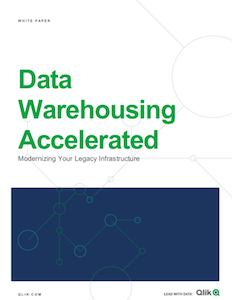- Sponsored
- Modernization
How agencies can modernize their data warehouse infrastructure

Federal agencies are faced with several daunting challenges exacerbated by the COVID-19 pandemic, that are causing them to take a second look at their IT investments and data strategies.
Among them, revamping data warehouse projects could be a good way to modernize and save their agency budget dollars to reallocate to more pressings needs.

Read the full report.
According to a recent Qlik report, a modern approach to data warehouse projects can address several key challenges, including improved cloud interoperability, replacing brittle legacy systems and end-of-life technology and addressing staffing constraints within the IT department
“This is a good opportunity for your teams to review technologies and choose a more modern, responsive approach,” says the report, “Data Warehousing Accelerated.”
There is often a reluctance to adopt new techniques within organizations that are invested in traditional data warehouses. However, modern solutions can bring automation to the processes and replace manually-coded, time-consuming and error-prone tasks, according to the report.
Today, more than ever, government agencies need to adopt greater agility to respond to mission needs. Data warehouse infrastructure is still critical for some agencies, and it will need to to keep up with changing data requirements so agencies can reduce siloes of information.
The Qlik Compose solution can bring modern capabilities across the data warehouse lifecycle, according to the report. That includes:
- Faster requirements gathering, warehouse design and creation with the ability to interpret existing logical data models and automatically generate physical schema in the relational database. The interface allows IT teams to adopt any or all of the different data warehouse styles as they design their warehouse.
- Automation of repetitive, manual tasks of creating, maintaining, testing and debugging data warehouse environments and code generation so incidences of typos and programming errors are dramatically reduced.
- Easier migration from development, test and user acceptance environments to production environments. The solution supports managing global variables for each environment, integrates with version control systems and offers both graphical and command-line interfaces to facilitate moving between environments.
- Change management capabilities so teams can adjust data relationships and transformation rapidly with automation.
Learn more about modernizing your data warehouse infrastructure.
This article was produced by FedScoop for, and sponsored by, Qlik.






